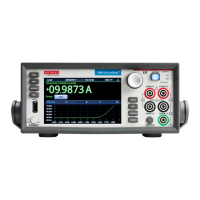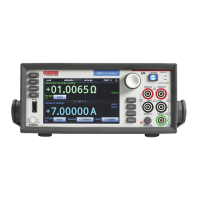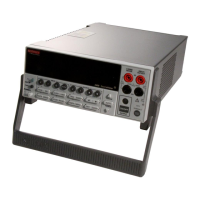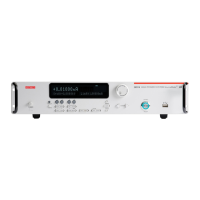6: SCPI command reference Model 2461 Interactive SourceMeter® Instrument
6-114 2461-901-01 A/November 2015
The time at the amplitude level for each pulse:
• Extended operating area: 10 A at 100 V, 5 % duty cycle, maximum pulse
width: 1 ms, minimum pulse width 150 µs (load dependent)
• Normal operating area (DC): 99.99 % duty cycle, maximum pulse width
10,000 s, minimum pulse width 150 µs
Enable or disable measurements at the top of each pulse:
• Enable: ON (default)
• Disable:
A string that indicates the reading buffer; the default buffers (
or
defbuffer2) or the name of a user-defined buffer; if no buffer is specified,
is used
The amount of time that the instrument stays at bias level before each pulse (in
seconds): 0 to 10,000 s
The amount of time that the instrument stays at bias level after each pulse (in
The number of pulse sweeps; default is 1:
• Infinite loop: 0
• Finite loop:
to
The current or voltage limit for the defined bias level:
• Current: 10 nA to 7.35 A
• Voltage: 2 mV to 105 V
The current or voltage limit for the defined pulse level:
• Current: 10 nA to 10.5 A
•
Determines if the sweep is stopped immediately if a limit is exceeded; options are:
• Abort the sweep if the source bias or pulse limit is exceeded: ON
•
Complete the sweep if the source limit is exceeded: OFF
Determines if the sweep runs from start to stop and then from stop to start:
• Sweep from start to stop only: OFF (default)
•
Sweep from start to stop, then stop to start: ON
Details
Before configuring a pulse operation, configure your measure settings. Pulse operations use the
measure settings that were last defined before the pulse operation; you may get unexpected results if
you do not define the measure settings first.
When the pulse sweep is started, the instrument sources a specific voltage or current voltage to the
device under test (DUT). A pulse is output for each step of the pulse sweep.
When the pulse sweep command is sent, it deletes the existing trigger model and creates a trigger
model with a uniform series of ascending or descending voltage or current changes, called steps. To
run the pulse sweep, initiate the trigger model.
The pulse sweep continues until the source outputs the stop level, which is calculated from the
number of steps. If measurements are enabled, a measurement is also made for each step of the
pulse sweep (including the start and stop levels). At this level, the instrument performs another
measurement and then stops the pulse sweep.
The instrument uses the step size parameter to determine the number of source level changes. The
source level changes in equal steps from the start level to the stop level. To avoid a setting conflicts
error, make sure the step size is greater than the start value and less than the stop value. To
calculate the number of source-measure points in a sweep, use the following formula:
Points = [(Stop - Start) / Step] + 1

